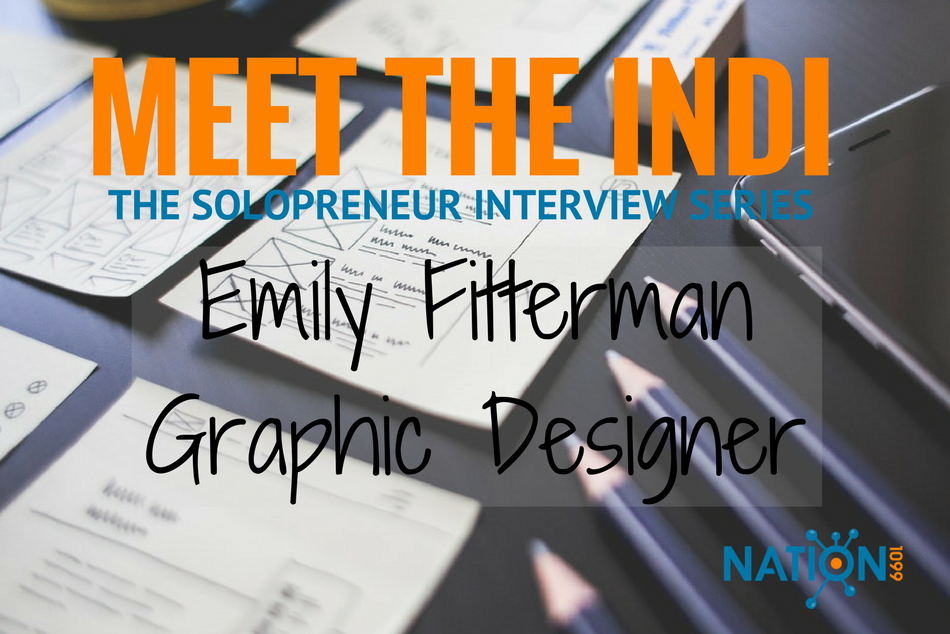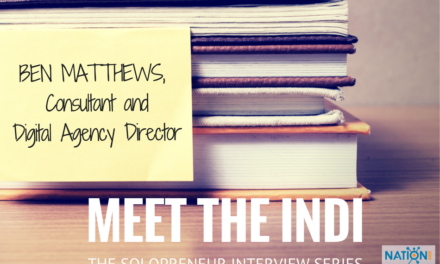Freelance graphic designer Emily Fitterman has over 25 years experience as an art director and in graphic design. She graduated from School of Visual Arts with a B.F.A. in advertising and honed her craft working for companies such as Random House, Penguin Publishing, PETCO and Jackson Hewitt.

Emily has been freelancing for eight years for clients ranging from financial companies to self-published authors to nonprofits.
What’s your specialty?
My services are freelance graphic design for print and web. My clients vary — corporate, financial, non-profit, small business, self-publishers, etc.
I mostly do print design, although the word “print” has taken on a new meaning with technology. Several of my finished pieces will never be professionally printed because they are solely designed to end up as PDFs on a website or email blast.
When asked what kind of design I do, my answer is usually “corporate” because that’s what my background is in. But I don’t really have a specialty or niche since my portfolio is pretty diverse.
I’m really good with type treatments and fonts. My first job out of college, I worked for two exceptionally talented art directors and I learned skills from them that I still use to this day.
What are your clients usually looking for?
Some of my clients are large companies that may have an in-house team that can’t handle the workflow so they outsource to a freelance graphic designer. Some clients don’t have a designer on staff at all, or they have someone who is entry-level and they need an experienced designer.
The business problems I’m asked to solve is to breakdown the information into a simpler form so the client can get their message or content to resonate with the audience. People are much busier these days and bombarded with marketing material via email and social media. My job is to use graphics to draw them in so they will want to stop and read it.
How do you set yourself apart as a freelance graphic designer from others your clients can choose from?
I’m fast, and clients like that. Fifteen years ago you could tell a client you needed two weeks to design a brochure. Technology has changed that, we don’t have that luxury anymore. The internet, telecommuting and email have changed the timing of projects.
Now clients need it in two days, sometimes by EOB when I just received it at 9 a.m. that same day.
I also have very little overhead so my rates for freelance graphic design can be lower than an agency. Larger companies may use an agency for their branding and marketing, but these agencies charge big bucks for the nitty gritty such as creating actual files for print or web.
That’s where I come in. The client gives me the agency’s idea, branding, guidelines, etc., and I blow it all out into usable pieces . . . much faster and much cheaper than an agency can.
Larger companies may use an agency for their branding and marketing, but these agencies charge big bucks for the nitty gritty such as creating actual files for print or web. That’s where I come in.
How do you find freelance clients?
The majority of my business has been word-of-mouth, people I worked with in the past or referrals from other clients. When work gets slow, I reach out to my network with a short email letting them know I’m still alive and able to work.
Related reading: How Smart Consultants Network Less and Make More With Current Clients
When did going freelance become a viable business rather than just a side hustle?
The last company I worked full-time for had restructured and eliminated my position, eventually getting rid of the entire creative team in marketing. I had made the decision I would try freelancing and see how far it would take me.
Six months later, I reached out to my former boss and she brought me back to the same company as a consultant. That’s when I realized I could really make something of this freelancing thing.
Freelancing has never been “full-time” for me because my children were young when I started. However now that my children are in school, my plan is to grow my business and seek out new clients or work on-site for clients, which in the past was more difficult with babies at home.
Related reading: Full-time, Part-time and Occassional – Data About Who Is in the Gig Economy
What observations do you have about how the gig economy is trending?
I think everything is cyclical even the gig economy. I don’t know if it’s necessarily trending, but people have jobs and then they don’t, so they try freelancing. Sometimes it’s lucrative and sometimes they go back to work full-time when the opportunity is presented.
Even when I was a full-time employee, I still freelanced. I think working as an independent contractor is a great way to build a career.
But it’s feast or famine and you have to be prepared to cover your living expenses when the money isn’t coming in as fast. Plus, you need to make sure you set aside enough money for the government’s cut.
What are you planning to try in the next year to grow your business?
Actually marketing myself, which I’ve never done before, and proactively looking for new clients.
What would you advise your younger self about growing a freelance business?
When I graduated college, I was very afraid to try freelancing. The idea of not having a steady paycheck, benefits, getting paid for sick days, made me extremely anxious. I would tell my younger self: Don’t be afraid.
I actually had one client offer to give me more money than I was charging her! That’s when I realized I was selling myself short.
Related reading: How to Start a Freelance Business In One Step? Why Reckless Is Best
What are some mistakes you made early on?
Setting rates too low for fear the client wouldn’t hire me. I actually had one client offer to give me more money than I was charging her! That’s when I realized I was selling myself short.
Related reading: Getting the Freelance Rate You Deserve
What goes into a good business relationship with clients?
Communication is key. Email makes it easier, but sometimes you just have to get on the phone to discuss projects.
And proofreading . . . very important! The rule of thumb is you should never proof your own stuff, do it anyway and then make sure to tell the client to proof it too.
A positive attitude also helps, even if you’re not feeling very positive about the project you are working on or the person you are working with. I’ve had some designer friends lose clients because they were “complainers.” In those cases, you just have to give the client what he or she wants and move on.
Related reading: 5 Signs Your Gorilla Client Has You Locked In A Cage
And proofreading . . . very important! The rule of thumb is you should never proof your own stuff, do it anyway and then make sure to tell the client to proof it too. Spending thousands of dollars to print something with a typo sucks.
I try my best to give the client what they want, but there are some clients who have not worked the solution out in their own heads. I could be designing for 10 years straight and they still won’t like anything I come up with.
I have found the best graphic design clients are the ones who have some idea or direction of what they are looking for. Even if it’s as simple as giving me samples of things they like or dislike.

Robert McGuire
Publisher of Nation1099
Robert McGuire is the owner of McGuire Editorial, a content marketing services firm specializing in B2B and tech startups.










